
The silver-ground carpet is a moth of the family Geometridae. The species was first described by Michael Denis and Ignaz Schiffermüller in 1775. It is common throughout the Palearctic region including the Near East and North Africa.It is found in a variety of different habitats and occurs, for example, in humid forests, moorland and shore areas, on embankments or on unimproved grass meadows and heathlands as well as in gardens.
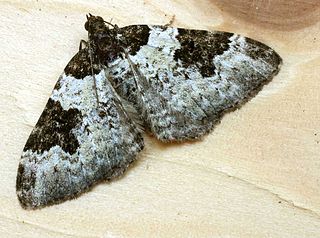
The garden carpet is a moth of the family Geometridae. It is an abundant and familiar species across its huge range which covers the whole Palearctic region from Ireland to Japan and including the Near East and North Africa. It was first described by Carl Linnaeus in his 1758 10th edition of Systema Naturae.

The clouded border is a moth of the family Geometridae. The species was first described by Carl Linnaeus in his 1758 10th edition of Systema Naturae. It is distributed across most of Europe to the Urals, western and central Siberia, Transbaikalia, Kazakhstan, Tian-Shan, northern Mongolia and parts of the Near East.

The brindled beauty is a Palearctic moth belonging to the family Geometridae.
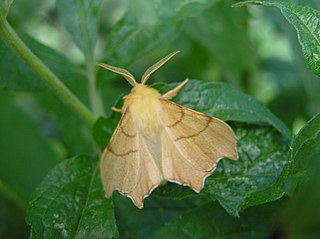
Ennomos erosaria, the September thorn, is a moth of the family Geometridae. The species can be found in the Palearctic realm in western Europe and from central Scandinavia. Its range extends to the northern Mediterranean and east to the Caucasus and Russia. It is widespread in mixed and deciduous forests in Europe. The south eastern occurrence reaches Turkey and the Caucasus. The main habitat is dry deciduous forests and parks. In the Southern Alps, the species rises to an altitude of about 1600 metres.

Theria primaria, the early moth, is a moth of the family Geometridae. It is found throughout Western Europe and the South Caucasus.

Plemyria rubiginata, the blue-bordered carpet, is a moth of the family Geometridae found in Europe and across the Palearctic. The moth was first described by the Austrian lepidopterists Michael Denis and Ignaz Schiffermüller in 1775.

Eupithecia simpliciata, the plain pug, is a moth of the family Geometridae. It is found in the Palearctic realm, from western Europe to north-western China (Xinjiang). The species primarily colonizes wastelands, rubble and abandoned vineyards, and in Asia also salt steppes. In the Alps, the range of altitude extends up to 1200 metres.
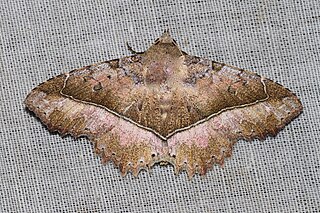
Tamba is a genus of moths in the family Erebidae. It was erected by Francis Walker in 1869.

Eupithecia venosata, the netted pug, is a moth of the family Geometridae, first described by the Danish zoologist Johan Christian Fabricius in 1787. It is found across the Palearctic realm from Portugal and Morocco in the west to the Lake Baikal in Siberia and Afghanistan and Pakistan in the east.
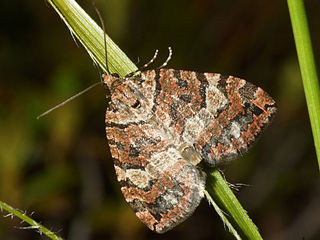
Hydriomena furcata, the July highflyer, is a moth of the family Geometridae. The species was first described by Carl Peter Thunberg in 1784. It is found in the Holarctic ecozone.

Berta chrysolineata is a species of moth of the family Geometridae described by Francis Walker in 1863. It is widespread from the Indo-Australian tropics of India, Sri Lanka to the Solomons.

Eucyclodes gavissima, the Oriental orange banded green geometer moth, is a species of moth of the family Geometridae described by Francis Walker in 1861. It is found in the Indian subregion, Sri Lanka, Bhutan, western China, Taiwan, Vietnam, Sumatra and Borneo.

Entephria caesiata, the grey mountain carpet, is a moth of the family Geometridae. The species was first described by Michael Denis and Ignaz Schiffermüller in 1775. It is found in the mountainous areas of Europe, the Caucasus, Asia Minor, Armenia, Russia, Russian Far East, Siberia, northern Mongolia, Sakhalin and Honshū in Japan.

Charissa obscurata, the annulet or Scotch annulet, is a moth of the family Geometridae. The species was first described by Michael Denis and Ignaz Schiffermüller in 1775. It is found in most of Europe including the European part of Russia and in Asia Minor, the Caucasus, Armenia and Azerbaijan. In the mountains it rises up to 1800 meters. The habitat is rocky dry grasslands, boulder corridors, quarries as well as rocky steppe heaths and wine-growing areas.
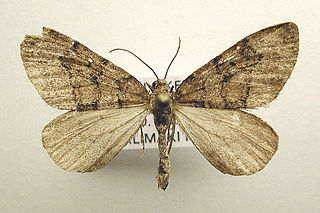
Thera cognata, the chestnut-coloured carpet or Durham juniper moth, is a moth of the family Geometridae. The species was first described by Carl Peter Thunberg in 1792. It is found in Europe, Asia Minor, the Caucasus and Transcaucasus.
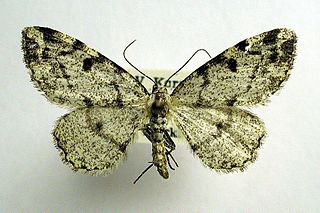
Alcis jubata, the dotted carpet, is a moth of the family Geometridae. The species was first described by Carl Peter Thunberg in 1788. It is found in central Europe, Scandinavia and northern Italy.

Collix stellata is a moth in the family Geometridae first described by William Warren in 1894. It is found in Korea, Japan, Taiwan and northern India.

Rhinoprora palpata is a moth in the family Geometridae. It is found in the Indian subregion, Sri Lanka and western China, as well as on Java, Borneo and Taiwan. The habitat consists of mountainous areas.

Hypochrosis hyadaria is a geometer moth in the subfamily Ennominae described by Achille Guenée in 1857. The species has a wide range from India, Sri Lanka through Southeast Asia.




















